From the June 2023 issue of Apollo. Preview and subscribe here.
This richly coloured goblet was made at a key moment in the history of science and of princely patronage, says Maartje Brattinga of the Rijksmuseum.
The life of the maker of this cup, Johann Kunckel, reads more or less like a novel. He was born around 1637 near the town of Plön, north of Hamburg, the son of an alchemist and glassmaker. He became an apothecary and a chemist, working first in Saxe-Lauenburg and later for the Elector of Saxony in Dresden, where his career as an alchemist began to take shape.
In Dresden, he was charged by John George II with sifting through his immense library, looking for clues to making gold. He must have been hugely excited by the vast number of books he was able to read. He stopped working there in 1677, and after lecturing for a year or so he was invited by Frederick William, Elector of Brandenburg and Duke of Prussia, to be director of the laboratory and glassworks at his court in Berlin. His new patron was so happy with his work that he gave him a whole island – Pfaueninsel, on the river Havel between Berlin and Potsdam – to establish his own laboratory and glassworks, where he was expected to produce wonderful glass objects but was also given freedom to experiment. Things went wrong when Frederick William died in 1688; his heir did not continue his support, and then Kunckel’s laboratory burned down. Soon afterwards, the King of Sweden brought Kunckel to Stockholm to sit on his Board of Mines; after a successful career in mining, he died, probably in Stockholm, in 1703.
Kunckel’s glassmaking and his alchemy should not be seen as distinct. Alchemists in the 17th century were not only searching for ways to make gold; they saw this as part of a larger quest to achieve the transmutation of substances. So, when Kunckel discovered a means of using gold to create a vivid, ruby-coloured glass – probably around 1684 – it would have been believed that he was very close to turning this process around, and transforming other kinds of matter into gold. And the nobility of Europe were not only looking for gold, but for any material they could make money from, whether that was gold ruby glass or – as was the case a couple of decades after Kunckel’s discovery – hard-paste porcelain, which by the mid 18th century had driven gold ruby glass out of fashion.
There’s a story that gold ruby glass was invented when a gold coin was accidentally dropped in the glass melt – but that’s rubbish. Kunckel was deeply knowledgeable about the work of other alchemists – and as the son of a glassmaker, he was intimate with the glassblowing process – and so his work was by no means random experimenting. He owned a copy of Antonio Neri’s L’Arte vetraria (‘The Art of Glass’, 1612), translated into English by Christopher Merrett. This was really a kind of cookbook for making all sorts of glass, with a big focus on colour; it includes several recipes for red glass using manganese or copper as a colourant. One of the recipes for red glass included gold, but the type of glass it produced could not be used to create vessels; the material was probably better suited for enamelling. When Kunckel tried to reproduce it, he failed.
Kunckel worked through and annotated all of the recipes in this book, adding ingredients or making comments like ‘this works’, or ‘you don’t have to cool it for this long’. He published his commentary, Ars vitraria experimentalis, in 1679. Next to a recipe for red glass using copper, he wrote that he knew a better way to make ruby glass and added teasingly: ‘Whoever does not believe that I can do it may come and see.’
The way he went about it was to combine the efforts of Neri with the work of two other alchemists, Johann Rudolf Glauber and Andreas Cassius, who developed a pigment called Purple of Cassius that formed the raw material for Kunckel’s gold ruby glass.
This is where it all gets a bit technical. Making gold ruby glass is all about breaking gold down into a colloid – dissolving it in a specific mixture of substances (for Purple of Cassius, a tin chloride) to produce a substance consisting of nanoparticles (the colloid) that colours the solution deep red. What Kunckel does is add this solution to the glass melt – which remains colourless until it is reheated, at which stage the colloid becomes fixed in the crystalline structure of the glass. If you heat it for too long, the glass becomes a dull, liver-like brown – so there is a delicate balance to strike.
Gold ruby glass would have been considered not just as glass with a new tint – it would have been regarded as an entirely new material. Drinking from gold – or indeed, drinking liquid gold, aurum potabile – was believed to have magical health-giving properties. It was very desirable – all of the great courts wanted to have objects made from gold ruby glass, and of course Kunckel’s formula leaked out and production proliferated across the glassworks of Europe; Augustus the Strong in Dresden added a couple of these goblets to his Green Vault. The one that the Rijksmuseum has just acquired, however, is unique in a number of ways.
The most significant of these is its shape. Among some of the early goblets made by Kunckel in Potsdam are some that, like this one, have engravings by Gottfried Spiller (1663–1728) depicting scenes with putti. But all of the known examples created by Kunckel are either cylindrical, like beakers, or have a more straightforward goblet shape – with a foot, a stem, and a symmetrical cup. The cup of the Rijksmuseum’s goblet takes the form of a shell, which makes the object appear more like carved stone or rock crystal than blown glass.
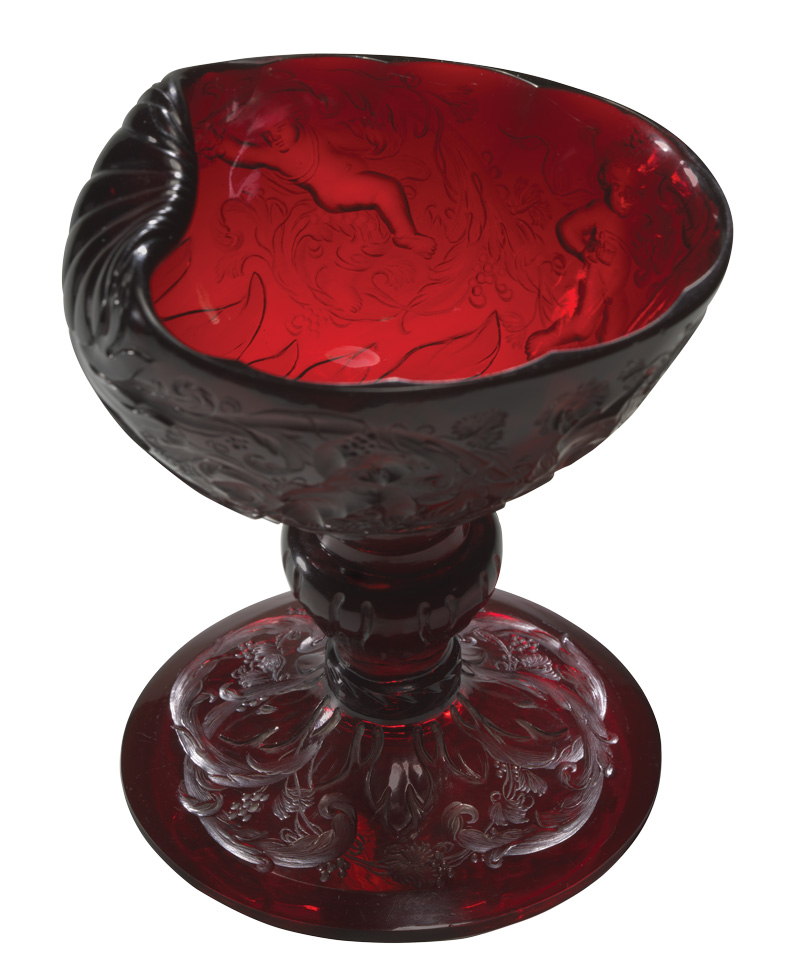
The cup of the goblet is in the form of a shell
Contrasting delightfully with the apparent heaviness of the object is the sweetness and light of its baroque decoration. We don’t know much about the degree to which Kunckel collaborated with Spiller on this – but Spiller, at this time and in this region, was the best engraver in the business and so he was the obvious choice for an object like this. The scene is lively, sweet and funny, with boys picking grapes from the vines and putting them in their baskets – an appropriate subject for a drinking vessel. I find it funny to compare it with our mental image of Kunckel, working with fire and dangerous chemicals in his laboratory. Working the glass like this, with decoration on all sides, would have been extremely difficult for Spiller. Running the cutting wheels required a huge amount of energy (a water-powered engraving workshop even opened in Berlin in 1687). Spiller would have spent many hours on this glass, and there would have always been the risk of the object losing its outline and becoming jagged. He has done a marvellous job of retaining the shape, while also making it look as though the boys are really alive.
The glass was undocumented before it emerged at TEFAF Maastricht in March. We don’t know the circumstances of its commission. We have some technical research to conduct, to verify the materials, but it has Kunckel and Spiller written all over it. It’s a new highlight of the Rijksmuseum’s glass collection, and it will go on display later this year – we also have in the collection the manuals by Neri and by Kunckel, so we will be able to tell a really complete story about this fascinating episode in history.
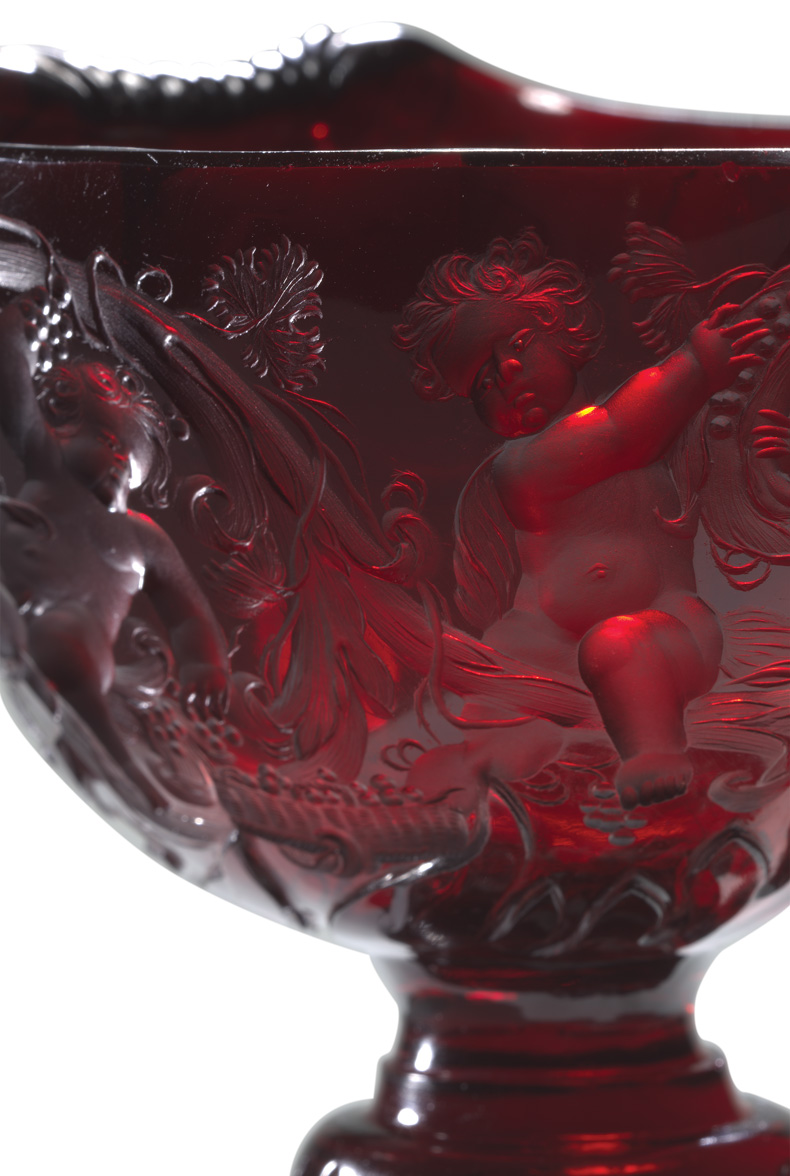
Gottfried Spiller’s engraving of grape-picking putti is a feat of technical mastery
Above all, the glass is a Kunstkammer object. A Kunstkammer, a cabinet of curiosities, was supposed to contain wonders of nature and wonders of man. This goblet is both – a marvel for the resemblance of the glass at once to stone and to a shell, achieved through human ingenuity. We acquired it with a wooden case, which fits like a glove, and which we therefore suspect might have been made for the original owner. This only enhances the image of a prince of Europe holding court among his friends, taking the goblet out, passing it round, discussing its magical qualities – perhaps taking a drink out of it – before putting it safely back in its case. ‘Look at the wonders I own!’ he might say. Every prince in Europe wanted to be like Rudolf II – the Holy Roman Emperor who was the 17th century’s greatest collector – and they would all have coveted an object like this for their collection.
As told to Samuel Reilly.
Maartje Brattinga is curator of glass at the Rijksmuseum, Amsterdam.
From the June 2023 issue of Apollo. Preview and subscribe here.
Unlimited access from just $16 every 3 months
Subscribe to get unlimited and exclusive access to the top art stories, interviews and exhibition reviews.


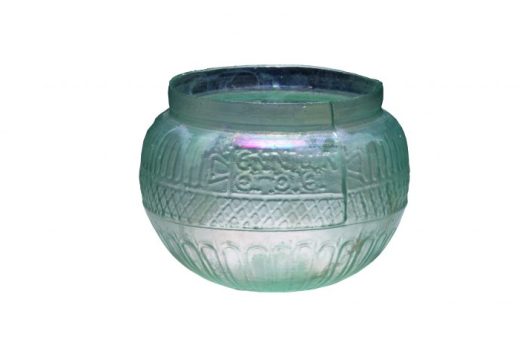
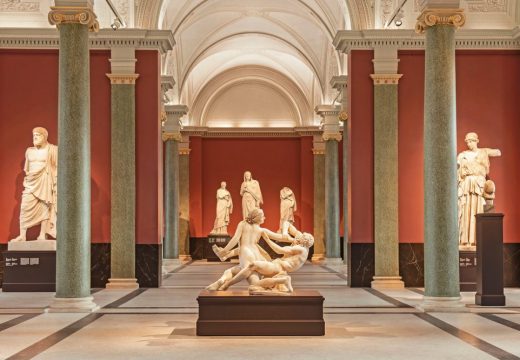
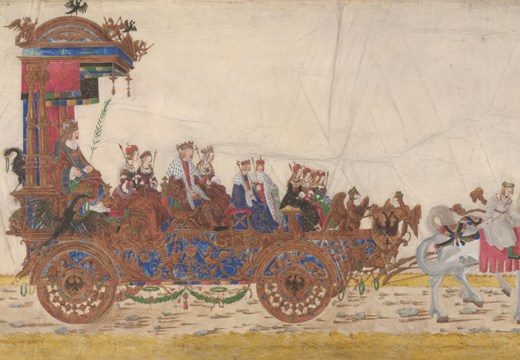









![Masterpiece [Re]discovery 2022. Photo: Ben Fisher Photography, courtesy of Masterpiece London](http://www.apollo-magazine.com/wp-content/uploads/2022/07/MPL2022_4263.jpg)
It’s time for the government of London to return to its rightful home